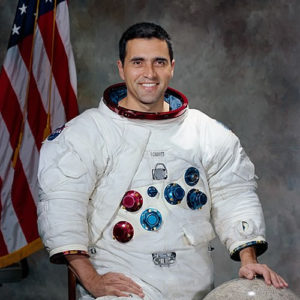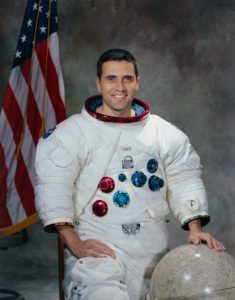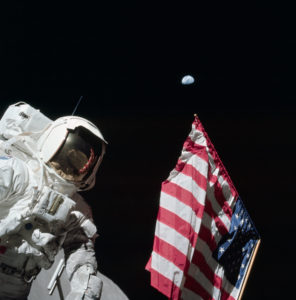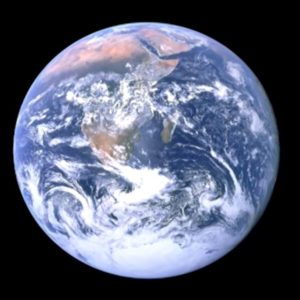
Born July 3, 1935, in Santa Rita, New Mexico, Schmitt grew up in nearby Silver City, and is a graduate of the Western High School (class of 1953). He received a B.S. degree in geology from the California Institute of Technology in 1957 and then spent a year studying geology at the University of Oslo in Norway. He received a Ph.D. in geology from Harvard University in 1964, based on his geological field studies in Norway.
 In December 1972, as one of the crew on board Apollo 17, Schmitt became the first member of NASA’s first scientist-astronaut group to fly in space. As Apollo 17 was the last of the Apollo missions, he also became the twelfth and second-youngest person to set foot on the Moon, and the second-to-last person to step off of the Moon (he boarded the Lunar Module shortly before commander Eugene Cernan). Schmitt also remains the first and only professional scientist to have flown beyond low Earth orbit and to have visited the Moon. He was influential within the community of geologists supporting the Apollo program and, before starting his own preparations for an Apollo mission, had been one of the scientists training those Apollo astronauts chosen to visit the lunar surface.
In December 1972, as one of the crew on board Apollo 17, Schmitt became the first member of NASA’s first scientist-astronaut group to fly in space. As Apollo 17 was the last of the Apollo missions, he also became the twelfth and second-youngest person to set foot on the Moon, and the second-to-last person to step off of the Moon (he boarded the Lunar Module shortly before commander Eugene Cernan). Schmitt also remains the first and only professional scientist to have flown beyond low Earth orbit and to have visited the Moon. He was influential within the community of geologists supporting the Apollo program and, before starting his own preparations for an Apollo mission, had been one of the scientists training those Apollo astronauts chosen to visit the lunar surface.
It is said to have been Schmitt who took the famous photograph of the Earth known as The Blue Marble, possibly one of the most widely distributed photographic images in existence.
 While on the Moon’s surface, Schmitt — the only geologist in the astronaut corps — collected the rock sample designated Troctolite 76535, which has been called “without doubt the most interesting sample returned from the Moon”. Among other distinctions, it is the central piece of evidence suggesting that the Moon once possessed an active magnetic field. Schmitt is reported to be the Astronaut who captured the famous “Blue Marble” photo of the earth (below)
While on the Moon’s surface, Schmitt — the only geologist in the astronaut corps — collected the rock sample designated Troctolite 76535, which has been called “without doubt the most interesting sample returned from the Moon”. Among other distinctions, it is the central piece of evidence suggesting that the Moon once possessed an active magnetic field. Schmitt is reported to be the Astronaut who captured the famous “Blue Marble” photo of the earth (below)
After the completion of Apollo 17, Schmitt played an active role in documenting the Apollo geologic results and also took on the task of organizing NASA’s Energy Program Office.
Schmitt resigned from NASA in August 1975 in order to run for election to the United States Senate as a member from New Mexico. As the Republican candidate in the 1976 election, he defeated the two-term Democratic incumbent Joseph Montoya.
Following his Senate term, Schmitt has been a consultant in business, geology, space, and public policy.
 Schmitt is an adjunct professor of engineering physics at the University of Wisconsin–Madison, and has long been a proponent of lunar resource utilization. In 1997 he proposed the Interlune InterMars Initiative, listing among its goals the advancement of private-sector acquisition and use of lunar resources, particularly lunar helium-3 as a fuel for notional nuclear fusion reactors.
Schmitt is an adjunct professor of engineering physics at the University of Wisconsin–Madison, and has long been a proponent of lunar resource utilization. In 1997 he proposed the Interlune InterMars Initiative, listing among its goals the advancement of private-sector acquisition and use of lunar resources, particularly lunar helium-3 as a fuel for notional nuclear fusion reactors.
Schmitt wrote a book entitled Return to the Moon: Exploration, Enterprise, and Energy in the Human Settlement of Space in 2006.
He lives in Silver City, New Mexico, and spends some of his summer at his northern Minnesota lake cabin.